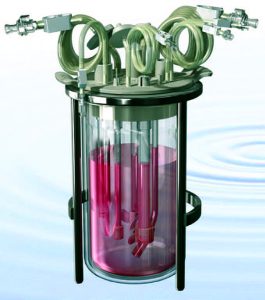
Distek’s BIOne system (WWW.DISTEKINC.COM)
Mark Arjona (product line manager, Distek) 1:00–1:20 pm
The bioprocessing industry has embraced single-use technologies recognizing their benefits of safety, cost, and throughput. Based in New Jersey, Distek is a leading manufacturer of single-use equipment.
The BIOne is a single-use bioreactor system consisting of a patent-pending, disposable headplate and liner that fit together into a bench-scale glass vessel. The liner molds to the contours of culture vessels (3 L or 7 L), keeping their geometry, aspect ratio, and volume all the same. The single-use headplate is prefitted with tubing, has the same ports, and can interface with a controller in the same way a stainless steel headplate does. But it does not need to be autoclaved. That allows users to quickly convert their traditional systems to single use while using an existing vessel, controller, probes, and agitator. By eliminating the cleaning and assembly steps of a traditional (reusable) set-up, users can save up to 48 hours (e.g., comparing 24 autoclavable bioreactors to a BIOne SUB system).
Customers will have their choice of four configurations — 2-L or 5-L working volumes with either a flute or a microsparger — which will meet the needs of most batch and fed-batch culture applications. Accessories currently in development include a septum port, other impeller and sparger configurations, an interface for cell-retention devices for continuous culture, and other customized designs.
BIOne equipment can be used with even the most sensitive cell lines. The liner is composed of three layers: one for structural integrity, one serving as a gas barrier, and an inner layer that provides a biologically inert interface for cultures. Its low antioxidant content minimizes exposure to degradants as well as the risk of cytotoxicity.
Distek compared BIOne single-use technology with glass vessels by evaluating process control and cell culture performance. To measure process control, the team looked at temperature and agitation maintenance as well as dissolved oxygen (DO) and pH profiles. They also evaluated Chinese hamster ovary (CHO) cell culture performance and protein production. After a seven-day production run, the BIOne system had effectively maintained both temperature and agitation set points. Similar DO and pH profiles were maintained within an acceptable range for both the BIOne system and the glass vessel. Growth profiles of CHO cultures were very similar for both systems. A final titer measured once the cultures reached 80% viability was comparable also.
BIOne implementation reduces turnaround time and the costs of cleaning, assembling, and autoclaving that come with a traditional system of glass vessels. When tested, the system performed similarly to a traditional system for cell culture growth, viability, and protein production using CHO, hybridoma, carcinoma, and mouse cell lines. The Distek BIOne SUB system will be available starting in summer 2016.
Listen to the full presentation at www.bioprocessintl.com/Interphex2016
